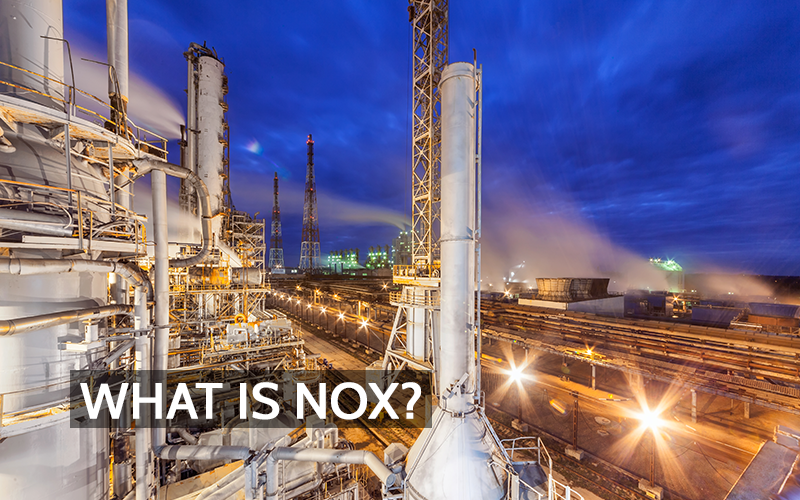Nitrogen oxides (NOₓ) are a group of highly reactive gases that include nitric oxide (NO) and nitrogen dioxide (NO₂). These gases play significant roles in atmospheric chemistry and environmental health. NOₓ contributes to the formation of ground-level ozone and fine particulate matter, both of which can lead to severely impact respiratory health. This article explores the formation, sources, and impacts of NOₓ, along with methods for reducing emissions and ongoing global efforts to address this pollutant.
Formation of NOₓ
NOₓ gases primarily form during high-temperature combustion processes where nitrogen and oxygen in the air react. The three main types of NOₓ include:
- Thermal NOₓ: Produced when atmospheric nitrogen is oxidized at high temperatures during combustion. This is common in power plants and vehicle engines.
- Fuel NOₓ: Results from the combustion of nitrogen compounds present in fossil fuels such as coal, oil, and natural gas.
- Prompt NOₓ: Formed through the reaction of nitrogen molecules with hydrocarbon radicals near combustion flames, though its contribution to overall NOₓ emissions is minimal.
Sources of NOₓ
The major contributors to NOₓ pollution include:
- Motor Vehicles: Internal combustion engines in cars, trucks, and buses emit significant amounts of NOₓ due to high-temperature fuel combustion. According to the EPA, vehicles account for nearly half of all NOₓ emissions in the United States.
- Power Plants: The burning of fossil fuels to generate electricity releases large quantities of NOₓ.
- Industrial Activities: Processes such as cement production, steel manufacturing, and waste incineration emit substantial NOₓ.
- Residential Heating: Use of furnaces, wood stoves, and other heating systems also contributes, particularly during colder months.
Health and Environmental Impacts
Exposure to NOₓ poses significant health risks. Nitrogen dioxide, a prominent NOₓ gas, can irritate the respiratory system, exacerbate asthma, and reduce lung function. Long-term exposure may lead to chronic respiratory diseases such as bronchitis and emphysema. Children, the elderly, and those with preexisting respiratory conditions are especially vulnerable.
Environmentally, NOₓ is a precursor to ground-level ozone (smog), which forms when NOₓ reacts with volatile organic compounds (VOCs) in the presence of sunlight. Smog not only harms human health but also damages crops, forests, and ecosystems. Furthermore, NOₓ contributes to the formation of acid rain, which acidifies soils and water bodies, harming aquatic life and reducing biodiversity.
Methods for Reducing NOₓ Emissions
Over the years, technological and policy-driven advancements have been made to control NOₓ emissions. Some of the most effective methods include:
- Selective Catalytic Reduction (SCR): This method involves injecting a reductant, such as ammonia or urea, into flue gases, where it reacts with NOₓ in the presence of a catalyst. SCR can achieve up to 95% NOₓ reduction, making it a preferred option for power plants and industrial facilities.
- Selective Non-Catalytic Reduction (SNCR): Similar to SCR but without a catalyst, this process uses ammonia or urea at high temperatures to reduce NOₓ into nitrogen and water. Although less efficient than SCR, SNCR is simpler and more cost-effective for smaller applications.
- Exhaust Gas Recirculation (EGR): By recirculating a portion of exhaust gas back into the engine’s intake, EGR reduces combustion temperatures and limits NOₓ formation. This method is widely used in modern vehicles.
- Low-NOₓ Burners: These are specially designed combustion systems that control flame temperature and oxygen availability to minimize NOₓ formation. They are commonly used in industrial boilers and furnaces.
In addition to these technologies, policy measures such as vehicle emissions standards, fuel regulations, and incentives for renewable energy adoption also play critical roles in reducing NOₓ emissions.
Global Reduction Initiatives
Efforts to reduce NOₓ emissions are ongoing at national and international levels. Some notable initiatives include:
- United States: The EPA has implemented the “Good Neighbor Plan” to reduce NOₓ emissions from power plants and industrial sources, particularly during the summer ozone season. This initiative uses a cap-and-trade program to ensure compliance and promote cost-effective reductions.
- European Union: The EU enforces stringent NOₓ emission standards for vehicles, power plants, and industrial facilities. Programs such as the Euro standards for vehicles have significantly reduced NOₓ levels across member states.
- International Maritime Organization (IMO): Under MARPOL Annex VI, the IMO regulates NOₓ emissions from ships. Ships operating in designated Emission Control Areas (ECAs) must use advanced technologies like SCR to meet strict NOₓ limits.
- China: The world’s largest NOₓ emitter, China, has taken aggressive steps to curb emissions by adopting low-NOₓ technologies in power plants and imposing strict regulations on vehicle emissions.
Despite these efforts, NOₓ reduction remains a global challenge due to growing energy demands, urbanization, and industrialization. Advancements in clean energy technologies, stricter enforcement of emission standards, and international cooperation will be crucial to achieving long-term reductions.
Nitrogen oxides are among the most harmful air pollutants, with far-reaching impacts on human health and the environment. Understanding their sources and implementing effective mitigation strategies is essential for improving air quality and protecting ecosystems. As countries continue to adopt innovative technologies and collaborate on global reduction initiatives, there is hope for a future with significantly lower NOₓ emissions.
Related Articles:
Air Quality Regulation and Standards in the United States: Addressing The Gaps
References:
- https://www3.epa.gov/airmarkets/progress/reports_2020-2021/emissions_reductions_nox.html
- https://en.wikipedia.org/wiki/NOx
- https://en.wikipedia.org/wiki/Selective_non-catalytic_reduction
- https://en.wikipedia.org/wiki/Vehicle_emissions_control
- https://www.epa.gov/sites/default/files/2020-07/documents/cs4-2ch2.pdf
- https://en.wikipedia.org/wiki/National_Ambient_Air_Quality_Standards


